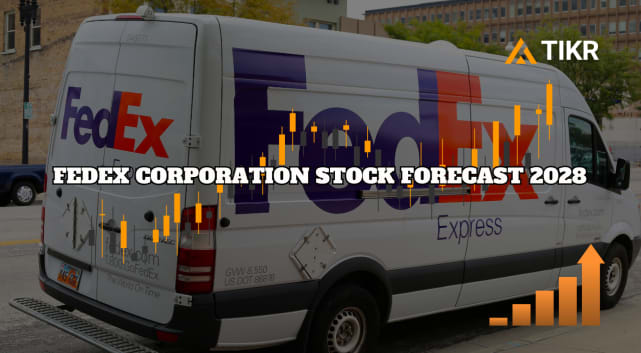Lockheed Martin Corporation (NYSE: LMT) has had a challenging stretch, with shares down about 14% from last year’s highs. The stock trades near $488, as defense budget delays and program timing weigh on short-term sentiment. Still, analysts see steady compounding potential backed by strong contracts and dependable cash flow.
Recently, Lockheed Martin won a major U.S. Navy contract for additional F-35 fighter jets and expanded its Next Generation Interceptor program to strengthen missile defense capabilities. These moves highlight the company’s leadership in advanced defense technology and its continued importance to national security.
This article explores where Wall Street analysts expect Lockheed Martin’s stock to trade by 2027. We have gathered consensus targets and valuation models to outline the stock’s potential path. These figures reflect current analyst expectations and are not TIKR’s own predictions.
Unlock our Free Report: 5 AI compounders that analysts believe are undervalued and could deliver years of outperformance with accelerating AI adoption (Sign up for TIKR, it’s free) >>>
Analyst Price Targets Suggest Modest Upside
Lockheed Martin trades around $488/share today. The average analyst price target is $517/share, which points to roughly 6% upside over the next year. Forecasts stay relatively tight, showing stable but cautious sentiment:
- High estimate: ~$630/share
- Low estimate: ~$430/share
- Median target: ~$525/share
- Ratings: 4 Buys, 2 Outperforms, 12 Holds, 1 Sell
It looks like analysts see some room for gains, but not a major breakout. For investors, this means Lockheed Martin is viewed as a steady performer with dependable earnings and limited downside risk. Its consistent execution and strong balance sheet continue to make it a long-term favorite among defense investors.

See analysts’ growth forecasts and price targets for Lockheed Martin (It’s free!) >>>
Lockheed Martin: Growth Outlook and Valuation
The company’s fundamentals remain solid, supported by steady defense spending and reliable contract flow:
- Revenue is expected to grow about 4% annually through 2027
- Operating margins should hold near 12%
- Shares trade around 17.5× forward earnings
- Based on analysts’ average estimates, TIKR’s Guided Valuation Model using a 17.5× forward P/E suggests the stock could reach around $615/share by 2027. That implies roughly 26% total upside, or about 11% annualized returns.
For investors, these numbers point to a stock that can quietly compound over time rather than surge quickly. Lockheed Martin fits best in portfolios built around stability, income, and long-term value, not short-term excitement.

Value stocks like Lockheed Martin in as little as 60 seconds with TIKR (It’s free) >>>
What’s Driving the Optimism?
Lockheed Martin’s long-term story remains intact. The company continues to secure large-scale contracts, including its recent multibillion-dollar F-35 and missile defense deals, which extend production visibility for years. Global defense budgets are also rising, especially in Europe and Asia, providing a steady stream of international opportunities.
Management’s focus on operational efficiency and disciplined capital allocation supports both margins and free cash flow. For investors, these strengths suggest Lockheed Martin has the stability and scale to keep compounding steadily, even if growth moderates. The company’s reliable dividend and predictable cash generation remain key parts of its long-term appeal.
Bear Case: Slower Growth and Budget Risks
Even with its advantages, Lockheed Martin’s growth potential has limits. Defense spending is cyclical, and any slowdown in U.S. budgets or contract awards could pressure near-term results. Margins also appear to have peaked, leaving less room for further improvement.
At roughly 17.5× forward earnings, the stock is not cheap compared to its slower growth profile. For investors, that means the bar for upside is higher, and returns could flatten if new contracts or production ramp-ups face delays. LMT remains a high-quality business, but expectations need to stay realistic.
Outlook for 2027: What Could Lockheed Martin Be Worth?
Based on analysts’ average estimates, TIKR’s Guided Valuation Model using a 17.5× forward P/E suggests Lockheed Martin could trade near $615/share by 2027. That would represent about 26% total upside, or roughly 11% annualized returns from current levels.
While that outlook reflects healthy compounding, it already assumes continued contract momentum and stable margins. To deliver stronger gains, Lockheed Martin would need to outperform on execution and expand its international footprint faster than expected.
For investors, the takeaway is clear: Lockheed Martin offers reliability, not fireworks. It is a stock built for steady income and long-term value preservation rather than rapid growth.
AI Compounders With Massive Upside That Wall Street Is Overlooking
Everyone wants to cash in on AI. But while the crowd chases the obvious names benefiting from AI like NVIDIA, AMD, or Taiwan Semiconductor, the real opportunity may lie on the AI application layer where a handful of compounders are quietly embedding AI into products people already use every day.
TIKR just released a new free report on 5 undervalued compounders that analysts believe could deliver years of outperformance as AI adoption accelerates.
Inside the report, you’ll find:
- Businesses already turning AI into revenue and earnings growth
- Stocks trading below fair value despite strong analyst forecasts
- Unique picks most investors haven’t even considered
If you want to catch the next wave of AI winners, this report is a must-read.
Click here to sign up for TIKR and get your free copy of TIKR’s 5 AI Compounders report today.








